_I asked Cat where she wanted to have our anniversary dinner and she said she'd been craving Japanese. And when it comes to Japanese food, Hanakazu will always be among the first restaurants I'll think of.
This traditional Japanese restaurant along Aguirre (near the Elizalde stoplight) -- now entering its seventh year of business -- is helmed by none other than the former chef of the posh Tsukiji restaurant in Makati, Hiroaki Otsuka. If you're a fan of Japanese food you'll already know what that means; if not, then let us quote you what they've put at the front page of their menu: "Fresh Sushi. Delectable sashimi. Crispy tempura. Tender Beef Sukiyaki. Mouth-watering Ebi Ten Maki." The descriptions do not exaggerate. From a small restaurant, Hanakazu has expanded its space to accommodate its growing clientele, a testament to Chef Otsuka's labor of love.
We ordered a perennial favorite, the Ebi Ten Maki, a sushi roll tenderly cradling crisp ebi tempura slices in its center; Miso Soup; a refreshing Kani Salad; Yakiniku (grilled beef); and Yakimeshi (fried rice).
All the dishes were made to the high standard that this popular restaurant has come to be known for -- all the ingredients are top-grade and fresh, the flavors light and ethereal, very well balanced -- you can see the chef's expertise in the way every roll of sushi here is rolled just so, the sashimi cut so neatly you'd swear fish grow in neat rectangles and lozenges.
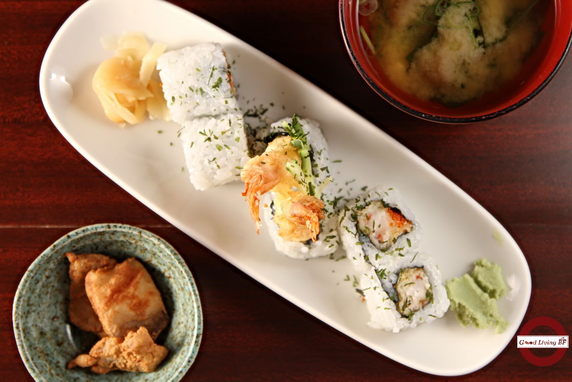 Ebi Ten Maki with Maguro Tatsutaage and Miso soup _As I said, we nearly always order the Ebi Ten Maki when we eat here; Hiroaki's wife Lorna says she's not sure whether this roll is Hiroaki's own invention or not, but she does get comments from foodies telling her Hanakazu's version is the best they've had. I agree. We also received tiny bowls of Maguro Tatsutaage, breaded tuna slices fried crisp, as a complementary appetizer.
A new revelation for us was the Kani Salad, a beautiful light salad of lettuce and assorted greens, carrots, and kani strips, tossed in a light semi-sweet mayo dressing and topped with strips of dried seaweed. The serving of this salad was surprisingly large, easily good for sharing among three or four. On its own, it can make a pretty filling meal for a health-conscious diner. We also loved our Yakiniku, the beef so tender we could tear apart the strips easily with our chopsticks, with a light soy-pepper-slightly-sweet flavor. The beef went perfectly with our sticky Yakimeshi.
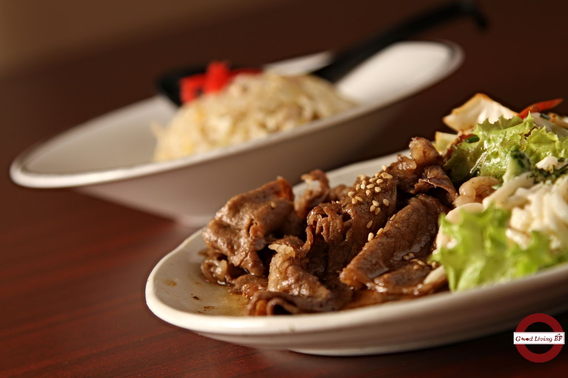 Yakiniku with Yakimeshi  Kani Salad _Chef Hiroaki was too busy to interrupt, but we were able to get Lorna Otsuka to drop by our tatami room and tell us more about Hanakazu. The restaurant's name is taken from their daughters, Hana and Kazuko. They and their two sons, Yoshi and Sachi (after whom the two tatami rooms are named), are the reason Chef Hiroaki is happy in BF Homes rather than taking up offers to open a Hanakazu branch in commercial districts like Makati. "We were tempted by an offer when Serendra was new, but when we found that we'd have to be open all week, my husband said no," reveals Lorna. "He wants his Mondays off, because that's his day to be with his children. That's the day he'll make them lunch himself as a treat."
The rest of the week, though, is spent keeping up the quality that Hanakazu's become known for. Though the restaurant opens at 11:30 a.m., Hiroaki arrives early to begin making the ramen broth, which he insists on making fresh every day. He also does the marketing for ingredients himself every three days, and they regularly receive shipments of locally hard-to-find items from Japan.
That passionate attention to detail is evident in every bite here at Hanakazu, which is why we've been regular customers since 2005. The staff even remembers my friends and I as "that noisy gang that always makes such a ruckus in the tatami room but orders a lot!", said with a smile, of course. Lorna said that their loyal customers now have "Hanakazu babies" -- you could say that we could count ourselves among them as well.
We've just discovered a new Japanese street food place along President's Avenue. It's called Kushiten, which in my fractured understanding of Japanese boils down to 'heaven for everything on a stick.' If you've a hankering for yakitori, this is the place to find it -- about a dozen varieties of it, and all of them made with an authentic, light Japanese touch.
Kushiten's secret weapon is owner/chef Kath Kaneko and her culinary blue blood - her father is a Japanese chef and their family used to own the Keiyu Japanese restaurant in Phase 3. Kushiten's menu is a reflection of what Kath herself loves most in Japan, its variety of skewered street foods. The menu was inspired by a street stall that she always visits when she goes to Tokyo. Banking on the Filipino's love for grilled and fried dishes, Kath designed Kushiten to showcase the streets of Tokyo's best in a casual, relaxing atmosphere that welcomes Japanese expats and Filipino barkadas and families alike.
 Left Photo (l-r): Tebasaki, Tsukune, Buta Aspara. Right Photo: Momo and Negima When I order yakitori, I usually know what to expect: tender bits of sweet-salty chicken on sticks. That's it. In Kushiten, though, there's a lot more to it than that. Cathy and I sampled Momo (chicken dark meat), Tebasaki (chicken wings), Tsukune (balls of ground chicken), Negima (chicken with leeks), and Buta Aspara (thin strips of pork rolled around fresh asparagus tips). I have to say Kath has a very light hand with her marinades, so you can savor every nuance of the ingredients' flavor without them being overwhelmed in sweetness or the saltiness of soy sauce. I can see why the Japanese expats eat here.
The yakitoris went very well with a bowl of Chahan, Japanese fried rice.
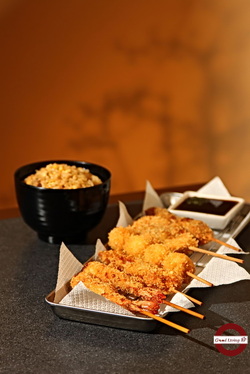 (From bottom) Kushiages - Ebi, Gyu, Uzura Tamago, Sakana, Ika After the yakitoris we tried a variety of kushiages, namely the Gyu (beef), Ika (squid), Sakana (fish), Ebi (shrimp,) and a surprise, the Uzura Tamago (quail eggs). By default these are served with a sweet kushiage sauce, but Kath also urged us to try them with tartare sauce and her own Kushiten sauce. One of the draws here, she explained, is that you can order kushiage with the sauce of your choice, including chili mayo and wasabi mayo if you want a hot kick. Cat and I found that each kushiage tends to go best with a different sauce -- the tartar was great with the fish and squid; I found the Kushiten sauce was fantastic with the quail eggsl and the sweet kushiage sauce went very well with the beef. If you're going to bring kids here, the kushiages are guaranteed to be a hit with them! Trust me - I'm very in
touch with my inner kid.
We also had a plate of fried Gyoza, an all-meat dumpling, again with Kath's own gyoza sauce. Cathy's a gyoza connoisseur, almost never failing to order it when we eat Japanese; so when she says she likes a gyoza, I know we're going there again. As for me, I liked that the gyoza sauce here has more ginger and is less sweet than usual; I find that it brings out the taste of the gyoza filling better. We then had our vegetables in the form of an Okonomiyaki, a sort of savory pancake made with shredded cabbage and topped with a light, sweet sauce, Japanese mayo, seaweed flakes and dried bonito flakes. This dish is surprisingly hefty, and can make a filling snack on its own or be a good side dish to go with the light yakitoris and kushiages.
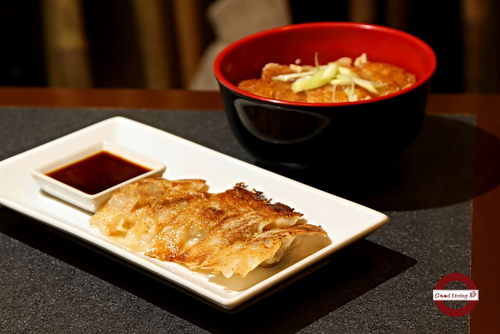 Gyoza and Katsudon As there's inevitably one big eater in every group, Kushiten is coming out with a line of donburis, or rice topping bowls, by next week. We got a sneak preview of the Katsudon, a breaded pork cutlet on rice. Kushiten's katsudon comes in a rather large serving, and is drenched in a special sauce that adds juiciness to the fried pork and makes the rice really savory. I guess this is the Japanese version of comfort food, so comforting I didn't want to get up from my chair anymore after I finished it! This friendly place with its delicious, authentic and surprisingly budget-friendly Japanese food is going to be among my top recommendations from now on.
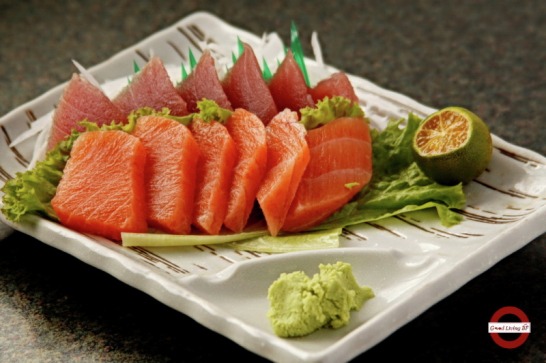 Salmon & Tuna Sashimi There's a very basic rule for eating regional cuisines: if you want the good stuff, go where the people from that region eat. And in BF Homes, one of the places where you'll almost always find a Japanese customer is Tatsunoko, formerly known as Bento-Ya. With its plain exterior and very simple sign, this little restaurant along El Grande can be easy to miss, yet I've found that it has a whole coterie of regulars.
As our dining-out trips almost always take us in the direction of Phase I, Cat and I had never tried this place before. It was time to remedy the oversight -- particularly as Tatsunoko has been reviewed very favorably before by other food writers. Its claim to fame is in preparing Japanese food exactly the way the Japanese themselves like it, even including dishes in its menu that are not often found in Japanese restaurants catering more to the Filipino taste (for example, the rather pungent natto).
Today Cat and I made arrangements for a late lunch/shoot, trying out the Negima (chicken barbecue with leeks), Oroshi Soba, Agedashi Tofu, and a plate of Salmon and Tuna Sashimi. I'm almost tempted to say the photos already declare everything I want to say about the food, but I have to put down words or this isn't a proper food blog. If I could use just one word, it would be: Oishii!!! Delicious!  Oroshi Soba The Salmon and Tuna Sashimi were very fresh, the cuts served to us all flesh/muscle with none of the tough ligament you sometimes get with lesser-grade sashimi. For its listed price (a mere PHP 200.00), I'd say this sashimi is a steal. Next came the Oroshi Soba, buckwheat noodles in chilled stock that's served in Japan as a refreshing summer treat. And refreshing this soba was, as well as very tasty. The noodles had a nice nutty flavor, and the sauce it was served in zesty with ginger, radish, and leeks, plus a nice crunch from the tenkatsu crumbs sprinkled on top. Cat says she thinks she can understand why the Japanese expats in the neighborhood choose to eat here: the food is made with a delicate touch that's very Japanese, the fresh natural flavors of the ingredients enhanced rather than covered up. 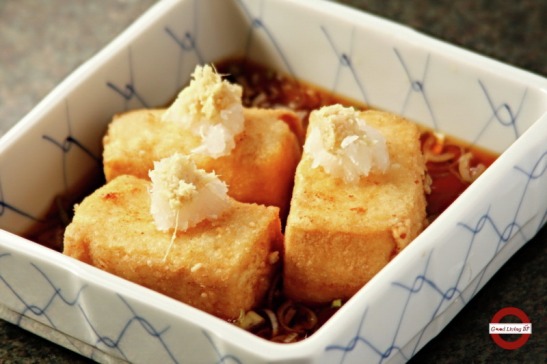 Agedashi Tofu 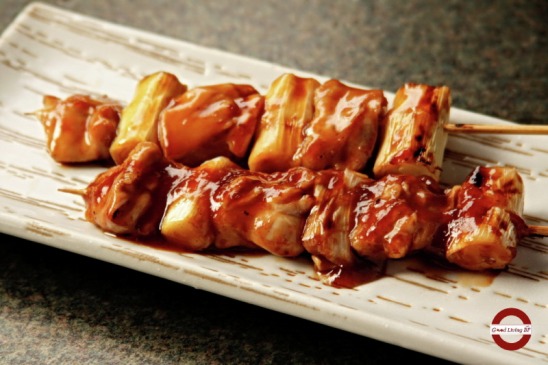 Negima The Agedashi Tofu was also very good. I love tofu, and I ask for it almost every time we eat Japanese. This tofu was very nicely made -- crisp outside, silky-creamy-soft inside, in a leek-and-soy sauce that was, again, so delicate in flavor you can taste every ingredient in it. The dish served last was the Negima, basically a yakitori with chunks of negi, leeks, threaded alternately with the chicken. The best yakitori is made with the juicier thigh, not the breast, and Tatsunoko's was as juicy and tender as I've ever had. Cat's a big fan of dark meat, so she was very happy with hers. Again, a nice very light flavor.
Conclusion: As this restaurant is actually on my way home when I'm coming from Lopez, I strongly suspect I'll be stopping here a lot more often from now on.
One of the great things about being a food blogger is that I get to write about something I really love. On the other hand, the bad thing about being a food blogger is that writing each and every blog post brings back a full-sensory recollection of the subject, making me really hungry. Which is exactly what's happening right now, as I review the pics I'm going to use for this entry on Kenji Tei.
Kenji Tei is a new ramen house along President Avenue that's been drawing raves, and with good reason. The food here, according to owner Kenneth Kho, is a blend of traditional Japanese ramen recipes and new Japanese-inspired fusion dishes. Why Japanese? Simple, says Kenneth, it's the food he likes best. Kho shared some of the house specialties with us in a marathon sampling session that started at one p.m. and ended at well past three. We got to try the Spicy Negi Ramen, a traditional Gomoku Shio Ramen, Crispy Chicken Teriyaki, fried Cheese Gyoza, traditional steamed Gyoza, and Chahan.
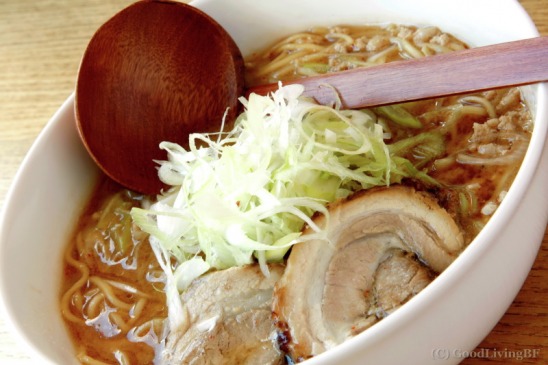 Spicy Negi Ramen The Spicy Negi Ramen was ramen noodles and succulent slices of roast pork floating in a bowl of rich, savory broth with a kick. This is exactly the kind of comfort food I'd look for after a really tiring day and something to pick up my spirits. The spicy soup also went very well with the Cheese Gyoza, pork dumplings in a thick dough wrapper, but fried crispy golden brown instead of steamed, with a nugget of creamily melted mozzarella cheese in the middle. The cheese gyozas are served with a dip of mayo and chili oil, which perfectly set off the mildness of the cheese. I can see why this is a crowd favorite! The Gomoku Shio Ramen will certainly please lovers of traditional style ramen--noodles in a very umami Japanese soup stock, topped with shrimp, beef, roast pork, cuttlefish, vegetables, and half a boiled egg, and it comes in a really big bowl. Were I dining alone, a bowl of this would be a match even for my rather wolfish appetite.
 Cheese Gyoza  Gomoku Shio Ramen Next came two dishes usually eaten with rice, though they also make great sides for ramen; the Crispy Chicken Teriyaki and steamed Gyoza. The teriyaki consisted of boneless pieces of chicken, skin on and fried to a nice crunch, glazed in Kenji Tei's special teriyaki sauce and rolled in fresh toasted sesame seeds. It's sweet-salty-peppery, crackling crisp outside and really tender inside. Cat of course was delighted with her favorite, the gyoza; it's something she invariably orders in every Japanese restaurant we go to. Which means I've tasted a lot of gyoza. Some are too salty, some soggy, some have a funny taste that's reminiscent of chorizo. Kenji Tei's gyoza was none of the above -- it was simply excellent. We had the teriyaki and gyoza with chahan fried rice, and I have to say Kenji Tei's cooks have a nice light hand with oil. I often find fried rice too oily, but this tasted like it had none at all.
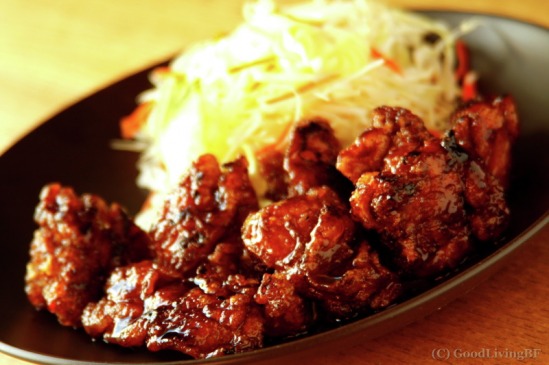 Crispy Chicken Teriyaki 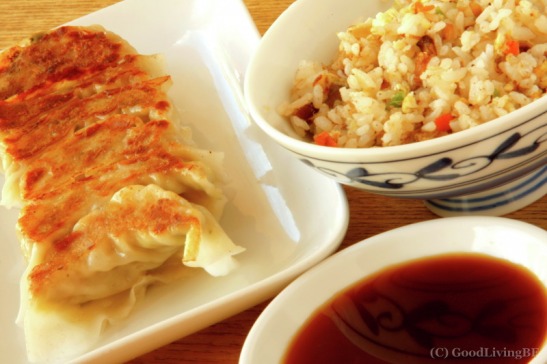 Gyoza with Chahan And now I've done it. I just had a nice, heavy dinner -- but my stomach is growling. Again. And it wants Japanese.
|
















 RSS Feed
RSS Feed